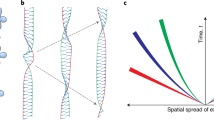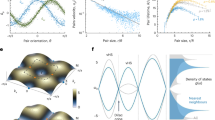Abstract
Hydrodynamics is a universal effective theory that describes the thermalization of chaotic many-body systems, and depends only on the symmetries of the underlying theory. Although the Navier–Stokes equations can describe classical liquids and gases, quantum fluids of ultracold atoms or quark–gluon plasma, they cannot yet describe the phases of matter where particle motion is kinematically constrained. Here we present the nonlinear fluctuating hydrodynamics of models with simultaneous charge/mass, dipole/centre of mass and momentum conservation. This hydrodynamic effective theory is unstable below four spatial dimensions: dipole-conserving fluids at rest are unstable to fluctuations, which drive the system to a dynamical universality class with qualitatively distinct features from conventional fluids. In one spatial dimension, our construction is reminiscent of the well-established renormalization group flow of the stochastic Navier–Stokes equations; however, the fixed point we find possesses subdiffusive scaling rather than the superdiffusive scaling of the Kardar–Parisi–Zhang universality class. We numerically simulate many-body classical dynamics in one- and two-dimensional models with dipole and momentum conservation, and find evidence for the predicted breakdown of hydrodynamics. Our theory provides a controlled example of how kinematic constraints lead to a rich landscape of dynamical universality classes in high-dimensional models.
This is a preview of subscription content, access via your institution
Access options
Access Nature and 54 other Nature Portfolio journals
Get Nature+, our best-value online-access subscription
$29.99 / 30 days
cancel any time
Subscribe to this journal
Receive 12 print issues and online access
$209.00 per year
only $17.42 per issue
Buy this article
- Purchase on Springer Link
- Instant access to full article PDF
Prices may be subject to local taxes which are calculated during checkout




Similar content being viewed by others
Data availability
The data used to generate Figs. 1–4 and Supplementary Figs. 1 and 2 are provided in Supplementary Data 2.
Code availability
The code used to run simulations is provided in Supplementary Data 1.
References
Landau, L. D. & Lifshitz, E. M. Fluid Mechanics 2nd edn (Butterworth Heinemann, 1987).
Crossley, M., Glorioso, P. & Liu, H. Effective field theory of dissipative fluids. J. High Energy Phys. 2017, 95 (2017).
Haehl, F. M., Loganayagam, R. & Rangamani, M. The fluid manifesto: emergent symmetries, hydrodynamics, and black holes. J. High Energy Phys. 2016, 184 (2016).
Jensen, K., Pinzani-Fokeeva, N. & Yarom, A. Dissipative hydrodynamics in superspace. J. High Energy Phys. 2018, 127 (2018).
Cao, C. et al. Universal quantum viscosity in a unitary Fermi gas. Science 331, 58–61 (2010).
Schemmer, M., Bouchoule, I., Doyon, B. & Dubail, J. Generalized hydrodynamics on an atom chip. Phys. Rev. Lett. 122, 090601 (2019).
Shuryak, E. Physics of strongly coupled quark–gluon plasma. Prog. Part. Nucl. Phys. 62, 48–101 (2009).
Crossno, J. et al. Observation of the Dirac fluid and the breakdown of the Wiedemann-Franz law in graphene. Science 351, 1058–1061 (2016).
Bandurin, D. A. et al. Negative local resistance caused by viscous electron backflow in graphene. Science 351, 1055–1058 (2016).
Krishna Kumar, R. et al. Superballistic flow of viscous electron fluid through graphene constrictions. Nat. Phys. 13, 1182–1185 (2017).
Chamon, C. Quantum glassiness in strongly correlated clean systems: an example of topological overprotection. Phys. Rev. Lett. 94, 040402 (2005).
Vijay, S., Haah, J. & Fu, L. A new kind of topological quantum order: a dimensional hierarchy of quasiparticles built from stationary excitations. Phys. Rev. B 92, 235136 (2015).
Vijay, S., Haah, J. & Fu, L. Fracton topological order, generalized lattice gauge theory, and duality. Phys. Rev. B 94, 235157 (2016).
Pretko, M. Subdimensional particle structure of higher rank U(1) spin liquids. Phys. Rev. B 95, 115139 (2017).
Pretko, M. Generalized electromagnetism of subdimensional particles: a spin liquid story. Phys. Rev. B 96, 035119 (2017).
Slagle, K. & Kim, Y. B. Fracton topological order from nearest-neighbor two-spin interactions and dualities. Phys. Rev. B 96, 165106 (2017).
Pretko, M. & Radzihovsky, L. Fracton-elasticity duality. Phys. Rev. Lett. 120, 195301 (2018).
Seiberg, N. & Shao, S.-H. Exotic U(1) symmetries, duality, and fractons in 3+1-dimensional quantum field theory. SciPost Phys. 9, 046 (2020).
Pai, S., Pretko, M. & Nandkishore, R. M. Localization in fractonic random circuits. Phys. Rev. X 9, 021003 (2019).
Sala, P., Rakovszky, T., Verresen, R., Knap, M. & Pollmann, F. Ergodicity breaking arising from Hilbert space fragmentation in dipole-conserving Hamiltonians. Phys. Rev. X 10, 011047 (2020).
Khemani, V., Hermele, M. & Nandkishore, R. Localization from Hilbert space shattering: from theory to physical realizations. Phys. Rev. B 101, 174204 (2020).
Gromov, A., Lucas, A. & Nandkishore, R. M. Fracton hydrodynamics. Phys. Rev. Res. 2, 033124 (2020).
Feldmeier, J., Sala, P., De Tomasi, G., Pollmann, F. & Knap, M. Anomalous diffusion in dipole- and higher-moment-conserving systems. Phys. Rev. Lett. 125, 245303 (2020).
Zhang, P. Subdiffusion in strongly tilted lattice systems. Phys. Rev. Res. 2, 033129 (2020).
Morningstar, A., Khemani, V. & Huse, D. A. Kinetically constrained freezing transition in a dipole-conserving system. Phys. Rev. B 101, 214205 (2020).
Iaconis, J., Lucas, A. & Nandkishore, R. Multipole conservation laws and subdiffusion in any dimension. Phys. Rev. E 103, 022142 (2021).
Ganesan, K. & Lucas, A. Holographic subdiffusion. J. High Energy Phys. 2020, 149 (2020).
Guardado-Sanchez, E. et al. Subdiffusion and heat transport in a tilted two-dimensional Fermi-Hubbard system. Phys. Rev. X 10, 011042 (2020).
Kardar, M., Parisi, G. & Zhang, Y.-C. Dynamic scaling of growing interfaces. Phys. Rev. Lett. 56, 889–892 (1986).
Spohn, H. Nonlinear fluctuating hydrodynamics for anharmonic chains. J. Stat. Phys. 154, 1191–1227 (2014).
Delacrétaz, L. V. & Glorioso, P. Breakdown of diffusion on chiral edges. Phys. Rev. Lett. 124, 236802 (2020).
De Nardis, J., Bernard, D. & Doyon, B. Hydrodynamic diffusion in integrable systems. Phys. Rev. Lett. 121, 160603 (2018).
De Nardis, J., Gopalakrishnan, S., Ilievski, E. & Vasseur, R. Superdiffusion from emergent classical solitons in quantum spin chains. Phys. Rev. Lett. 125, 070601 (2020).
Toner, J., Tu, Y. & Ramaswamy, S. Hydrodynamics and phases of flocks. Ann. Phys. 318, 170–244 (2005).
Hanai, R. & Littlewood, P. B. Critical fluctuations at a many-body exceptional point. Phys. Rev. Res. 2, 033018 (2020).
Mazenko, G. F., Ramaswamy, S. & Toner, J. Breakdown of conventional hydrodynamics for smectic-A, hexatic-B, and cholesteric liquid crystals. Phys. Rev. A 28, 1618–1636 (1983).
Simon, S. H. In Composite Fermions (ed. Heinonen, O.) 91–194 (World Scientific, 1998).
Gromov, A. Towards classification of fracton phases: the multipole algebra. Phys. Rev. X 9, 031035 (2019).
Bhattacharyya, S., Rodriguez-Nieva, J. F. & Demler, E. Universal prethermal dynamics in Heisenberg ferromagnets. Phys. Rev. Lett. 125, 230601 (2020).
Rodriguez-Nieva, J. F., Orioli, A. P. & Marino, J. Universal prethermal dynamics and self-similar relaxation in the two-dimensional Heisenberg model. Preprint at https://arxiv.org/abs/2106.00023 (2021).
Hohenberg, P. C. & Halperin, B. I. Theory of dynamic critical phenomena. Rev. Mod. Phys. 49, 435–479 (1977).
Glorioso, P., Delacrétaz, L., Chen, X., Nandkishore, R. & Lucas, A. Hydrodynamics in lattice models with continuous non-Abelian symmetries. SciPost Phys. 10, 015 (2021).
Grosvenor, K. T., Hoyos, C., Peña-Benitez, F. & Surówka, P. Hydrodynamics of ideal fracton fluids. Phys. Rev. Res. 3, 043186 (2021).
Lepri, S., Livi, R. & Politi, A. Heat conduction in chains of nonlinear oscillators. Phys. Rev. Lett. 78, 1896–1899 (1997).
Lee-Dadswell, G. R., Turner, E., Ettinger, J. & Moy, M. Momentum conserving one-dimensional system with a finite thermal conductivity. Phys. Rev. E 82, 061118 (2010).
Das, S. G., Dhar, A., Saito, K., Mendl, C. B. & Spohn, H. Numerical test of hydrodynamic fluctuation theory in the Fermi-Pasta-Ulam chain. Phys. Rev. E 90, 012124 (2014).
Slagle, K., Prem, A. & Pretko, M. Symmetric tensor gauge theories on curved spaces. Ann. Phys. 410, 167910 (2019).
Seiberg, N. & Shao, S.-H. Exotic symmetries, duality, and fractons in 2+1-dimensional quantum field theory. SciPost Phys. 10, 027 (2021).
Dua, A., Sarkar, P., Williamson, D. J. & Cheng, M. Bifurcating entanglement-renormalization group flows of fracton stabilizer models. Phys. Rev. Res. 2, 033021 (2020).
Iaconis, J., Vijay, S. & Nandkishore, R. Anomalous subdiffusion from subsystem symmetries. Phys. Rev. B 100, 214301 (2019).
Acknowledgements
We acknowledge useful discussions with L. Delacrétaz, B. Halperin, X. Huang, K. Jensen, R. Nandkishore, L. Radzihovsky and D. T. Son. This work was supported by the Department of Energy through award DE-SC0019380 (P.G.), the Simons Foundation through award no. 620869 (P.G.), the National Science Foundation under CAREER Award DMR-2145544 (A.L.), the Gordon and Betty Moore Foundation’s EPiQS Initiative via grants GBMF4302 and GBMF8686 (J.F.R.-N.) and GBMF10279 (J.G. and A.L.), and by Research Fellowships from the Alfred P. Sloan Foundation under grant FG-2020-13615 (P.G.) and FG-2020-13795 (A.L.).
Author information
Authors and Affiliations
Contributions
P.G. and A.L. developed the theoretical framework and classical models. J.F.R.-N. and J.G. performed the numerical simulations and statistical analysis of the data, and prepared the figures. P.G. and A.L. wrote the manuscript with input from all the authors.
Corresponding authors
Ethics declarations
Competing interests
The authors declare no competing interests.
Peer review
Peer review information
Nature Physics thanks the anonymous reviewers for their contribution to the peer review of this work.
Additional information
Publisher’s note Springer Nature remains neutral with regard to jurisdictional claims in published maps and institutional affiliations.
Supplementary information
Supplementary Information
Supplementary Figs. 1 and 2 and Sections 1–7.
Supplementary Data 1
MATLAB codes used to run the simulations and generate the data for models A and B.
Supplementary Data 2
Raw data used to generate Figs. 1–4 and Supplementary Figs. 1 and 2.
Rights and permissions
About this article
Cite this article
Glorioso, P., Guo, J., Rodriguez-Nieva, J.F. et al. Breakdown of hydrodynamics below four dimensions in a fracton fluid. Nat. Phys. 18, 912–917 (2022). https://doi.org/10.1038/s41567-022-01631-x
Received:
Accepted:
Published:
Issue Date:
DOI: https://doi.org/10.1038/s41567-022-01631-x
This article is cited by
-
Fracton gauge fields from higher-dimensional gravity
Journal of High Energy Physics (2024)
-
Goldstone bosons and fluctuating hydrodynamics with dipole and momentum conservation
Journal of High Energy Physics (2023)
-
Dipole superfluid hydrodynamics
Journal of High Energy Physics (2023)
-
Fractons’ exotic flow
Nature Physics (2022)



